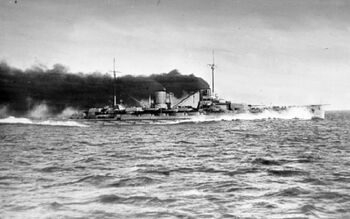Ruvelkan Battlecruiser Khoytka
This article is incomplete because it is pending further input from participants, or it is a work-in-progress by one author. Please comment on this article's talk page to share your input, comments and questions. Note: To contribute to this article, you may need to seek help from the author(s) of this page. |
 Khoytka in 1907.
| |
| History | |
|---|---|
| Name: | Khoytka |
| Namesake: | Battle of Khoytka |
| Ordered: | 1 February 1904 |
| Builder: | Soós, Barna & Antal, Mátészalka |
| Laid down: | 23 June 1904 |
| Launched: | 16 September 1906 |
| Commissioned: | 5 October 1906 |
| Fate: | Transferred to the Imperial Navy. |
| History | |
| Name: | Khoytka |
| Namesake: | Battle of Khoytka |
| Acquired: | 11 January 1915 |
| Commissioned: | 15 January 1915 |
| Struck: | 12 March 1938 |
| Fate: | Scuttled on 11 May 1934 during the Invasion of Ruvelka to prevent capture; hull eventually broken up for scrap in 1940 |
| General characteristics | |
| Class and type: | Khoytka-class battlecruiser |
| Displacement: |
|
| Length: | 186.6 meters |
| Beam: | 29.4 meters |
| Draft: | 9.19 meters |
| Propulsion: |
|
| Speed: | 25.5 knots (47 km/h) |
| Range: | 4,120 nmi at 14 knots |
| Complement: | 1,053 officers and crew |
| Armament: |
|
| Armor: |
|
Khoytka was a battlecruiser built for the Ruvelkan Red Navy leading up to the Third Chryse War and Ruvelka’s first post-dreadnought warship. Khoytka was to be the first of the planned Khoytka-class battlecruisers, but complications with her construction and the shelling of the second hull during the Third Chryse War rendered Khoytka the only ship of the class to be built and put to sea. Although there were later plans by the Socialist Republic to revisit procuring her sister ships, the outbreak of the Ruvelkan Civil War cancelled any tentative plans for expanding the Ruvelkan Navy.
Although the overall performance of the Red Navy was poor during the Third Chryse War, the Khoytka was the only notable exception. Khoytka was often sortied on her own or in battlegroups with allied Górska. She was a very modern design prescribing to the new uniform battery seen in dreadnought designs across Tyran; it was later revealed in the lead up to the Siduri War that the Ruvelkans received significant assistance from communist-sympathetic Cacertian naval officer Ninnia Regula.
On 30 November 1914, then Captain Sára Vörös—by then a member of the Imperial Separatist Movement—ordered the Khoytka to put to sea from its homeport in Mátészalka. When the 1914 December Uprising began the next month, Captain Vörös informed Red Navy command the intention of her crew to defect. The Khoytka played a key role in the Imperial capture of Mátészalka in February, spending the remainder of the war providing naval gunfire for Imperial operations along the northern coast of Ruvelka. After the civil war, the Khoytka continued to serve in its capacity as the flagship of the navy and ferried Princess Rózsá Prohászka to several state visits.
In late 1933, the Khoytka was put in for a refit at her homeport in order to modernize her equipment and armament. The refit was only partially completed by the time of the Invasion of Ruvelka. Crew of the Ruvelkan Imperian Navy attempted to bypass the engine repairs to get the vessel underway, but these efforts proved unsuccessful. With elements of the Army of the Syaran Republic quickly advancing, the decision was made to scuttle the ship to prevent it from falling into enemy hands.
Her wreck was not raised until after the conclusion of the Siduri War an she was eventually scrapped in 1940.